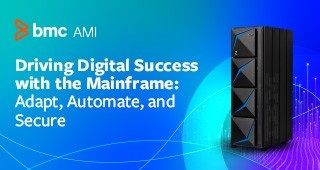Picture this, you are late to work, taking the quickest route possible, then disaster strikes, and you get stuck at a red light. No one is coming, but you still must wait… and wait… and wait. Sound familiar? When it comes to managing MLC on the mainframe, defined capacities (DCs) or softcaps are often used to limit the rolling 4-hour average (R4HA) and control spend. Much like stoplights, DCs also limit throughput according to a static setting, producing bottlenecks often when you need throughput the most. In a world full of varying demand, static settings won’t do. You need a dynamic option that can act based on the current situation. For traffic, that option is roundabouts, for capacity we have BMC’s Intelligent Capping for zEnterprise®.
Roundabouts vs Stoplights: Dynamic vs Static
Traffic lights are a rigid system, programmed based on data from traffic patterns. The traffic light is coded to provide an optimal traffic flow, but the information may be outdated. With a roundabout, the system adapts to the current situation. If there aren’t many cars on the road, everyone can flow through the intersection without slowing down. With heavy traffic, the system adjusts, and people slow down to take their turn to move through.
Traditional management of MLC by capping with defined capacities is very much like using traffic lights. It is planned with the best of intentions, for safety and consistency but is not always optimized for the current situation. The daily changes in workload demand, workload importance profiles or new workloads expose the flaws of defined capacities often at the expense of missing SLAs and impacting customer satisfaction. Intelligent Capping is like the roundabout, where the immediate situation is optimized. LPARs and their current workload profiles are accounted for, allowing for dynamic decision making.
Traffic lights make people wait indiscriminately. Roundabouts put a little burden on the individual but result in a much more efficient system overall. Intelligent Capping assumes the responsibility by assessing the importance level of the LPAR, workload importance profile, and cost per MSU. It allows you to manage the R4HA as if you had assigned an expert to constantly make changes on the business’s behalf.
The Problem with “Free” Defined Capacity
Is your workflow bound by rigid “stoplight” models? No matter where your cap is set, having a static defined capacity limit is simply a “best guess” for capacity needs. It lacks the necessary flexibility to appropriately respond to changing demands. If you set the cap too high, you miss out on cost savings, set it too low and you risk SLAs. Perfecting that balance is very difficult and without the flexibility to adapt to changes, you could see negative impacts. Even group defined capacities pose a risk from being static. Once the group defined capacity is reached, the LPARs “lock down” to their weighting. This is also a problem if you are considering moving to Container Pricing or Mobile Workload Pricing as these models are not considered when capping.
Intelligent Capping: A Responsive Workflow Traffic Model
Intelligent Capping for zEnterprise® is a dynamic, responsive capacity model built to maximize workflow. By adjusting based on real-time data, Intelligent Capping can manage the peak R4HA while maximizing the throughput of your important workloads. It can dynamically adjust individual LPAR’s defined capacities to meet current need. Wait or yield rules only come up as a last resort, and then are subject to workload importance profiles across the entire environment. Actions are taken based on what is happening now versus a “best guess” based on old data.
Intelligent Capping allows you to:
- Eliminate complexity by managing changes to capping limits automatically
- Manage capacity as it seeks to avoid capping unless absolutely necessary
- Leverage “Cost per MSU”, and nuances of various pricing models to ensure MSUs are allocated to highest priority workloads, while keeping costs in check
- Target costly, low-importance workload traffic, while ensuring the most important workloads aren’t capped
- Account for the latest pricing models such as Container Pricing
Maximize your environment with Intelligent Capping’s Dynamic Roundabout approach
The goal of Intelligent Capping is to reduce delays and improve traffic flow, making capping more efficient, eliminating waste and increasing availability. Your mainframe workflows and operations then benefit from:
- Quick, efficient continuous decisions
- Increased availability and resiliency
- Flexible response to change
- Reduced wasted effort
- Reduced risk to SLAs
Kemper, a leading insurance company in the U.S. uses Intelligent Capping to reduce peak MSUs and ensure cost savings. Technical services manager, John Campbell commented, “Intelligent Capping dynamically controls peaks without delaying critical workloads…an 18% to 20% reduction in my MSU utilization”. You can read about John’s success here. Then, take a look at your own mainframe environment and assess whether you are currently operating with stoplights or efficient roundabouts.







